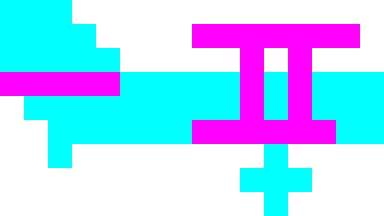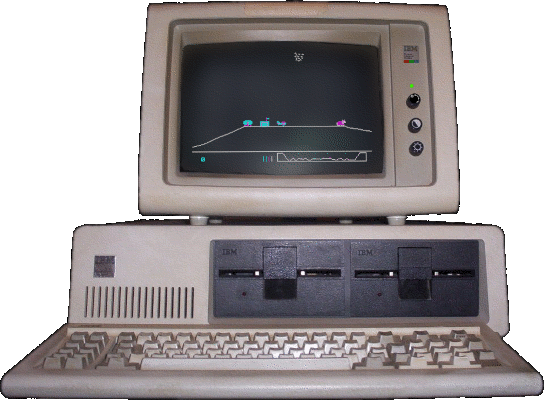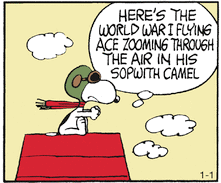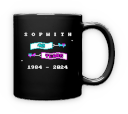 SDL Sopwith
SDL Sopwith
[
Play in browser |
Download |
Screenshots |
Github Page |
Discord |
History |
Links
]
History of Sopwith
[ Introduction | Imaginet | Sopwith escapes | DOS versions | On the Internet ]

Sopwith recently celebrated its 40th birthday, making it a very old game. It has an interesting history that deserves to be documented.
First released in 1984, Sopwith was one of the first games for the IBM PC. Released less than three years after the release of the IBM PC in August 1981, Sopwith sits within the “first wave” of games developed for the system. The PC remains an important platform for games to this day.
Sopwith is one of the earliest networked games, and indeed was developed as a demo program for the proprietary Imaginet system, an early form of LAN developed by BMB Compuscience of Ontario, Canada. Sopwith was not the first networked game; other contemporary examples exist, including Maze War and SGI Dogfight. However, at the time of its release there were still relatively few other examples. An unfortunate detail is that the game only worked with the proprietary BMB hardware and drivers, meaning that very few people were able to use this feature.
Sopwith is one of the oldest video games still in active development today. In 2018, PC Gamer published a list of old games still being maintained and developed. Sopwith is not on the list, but the only game on the list arguably older is Hack (1984), released several months earlier and still under development in the form of NetHack. SDL Sopwith is directly derived from the source code to the original DOS versions, and still includes changelog comments that date all the way back to 1984.
About BMB Compuscience

Sopwith’s title screen proudly identifies it as the work of BMB Compuscience, a Canadian company founded in 1979 and based in Milton, Ontario by Bill MacLean, Marcel Brunschweiler and Barbara MacLean. The initials of their first names were the origin of the name BMB. The business originally acted as a reseller for Commodore computers, targeting scientists and researchers. BMB then pivoted to focus on the IBM PC after it was released in 1981. This proved to be a smart move and BMB racked up enough in sales that it was able to open six retail stores.
The company went public in 1983 but then experienced difficulties the following year after a market downturn. BMB responded by discontinuing the retail side of its business to focus on its own hardware and software products.
Some websites have suggested that BMB went out of business as a result of litigation but this is not the case. BMB was involved in a landmark ruling in Canadian trademark law named BMB Compuscience Canada Ltd v Bramalea Ltd. and this appears to be the origin of this myth. The company continued into the ’90s before being acquired by Systems Xcellence Inc. in 1994 in a reverse takeover. The company later changed its name to SXC Health Solutions, and then Catamaran Corporation, before being acquired by UnitedHealth Group in 2015.
- National Post article from 1985 which provides some details about BMB.
The inspiration

The Sopwith Aviation Company was founded by aviation pioneer Thomas Sopwith in 1913. After World War I broke out, it became one of the main manufacturers of military planes for the war effort. This included the 1½ Strutter two seat general purpose biplane, and the Pup and Triplane fighter planes.
Technology advanced quickly over the course of the war and the Pup was quickly rendered obsolete; the Sopwith Camel F.1 was an evolution of the design that was faster, more manoeuvrable and more heavily armed. It acquired its (unofficial) name as a result of a metal fairing over the gun breeches that gave the appearance of a hump. While the game does not clarify which Sopwith plane is being flown, it is assumed to be a Camel, since it is one of the most famous planes of the war; certainly the most famous produced by the Sopwith Aviation Company.

Camel pilots shot down 1,294 enemy aircraft over the course of the war, more than any other aircraft. The plane gained a reputation for being agile but difficult to fly; many novice pilots crashed the plane on takeoff. 5,490 Sopwith Camel aircraft were produced.
In popular culture the Camel is known for being the biplane flown by the protagonist in the Biggles series of novels, and also by Snoopy in the Peanuts comic strip (in his imagined dogfights with “The Red Baron”).
Next: Imaginet
